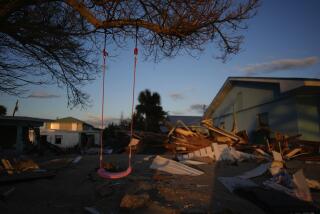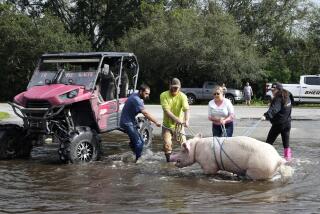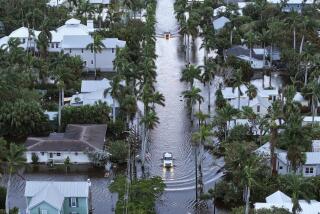More misery
- Share via
PENSACOLA — Emergency crews struggled Friday to reach areas hit hardest by Hurricane Ivan as residents learned that some of the miseries wrought by the storm will plague them for weeks.
Rescue teams, getting to barrier islands for the first time since Ivan struck more than a day earlier, found houses swept away by huge waves driven ashore by the hurricane. One man was pulled still alive from the wreckage of his home.
The death toll from Ivan in Northwest Florida stood at 15 on Friday. But search crews from throughout the state, including teams from the Orlando and Orange and Seminole county fire departments, still were unable to reach many of the worst areas on the islands.
U.S. Sen. Bill Nelson, D-Fla., who was given a helicopter tour of the coast Friday, said the storm’s waves swept away everything in their path.
“I’ve been through the aftermath of several hurricanes now for the last decade, and I have never seen a wall of water have such an effect,” Nelson said.
On one barrier island, rescuers found Richard Lowery, a retired deputy sheriff, buried in rubble when his house collapsed, said Escambia County Sheriff Ron McNesby. The man was injured but conscious and expected to survive, he said.
The sheriff said he expected more victims would be found in coming days as rescue teams, some using dogs trained to locate bodies, broadened their searches. Many of those were in areas where some residents defied evacuation orders.
Victims’ calls haunt workers
“We had calls from people screaming, saying, ‘I’m in my home, and I can’t get out! The water is up to my shoulders!’ ” McNesby said.
Some emergency workers were haunted by the pleas they received during the height of the storm, when deputies could not venture out.
“I don’t know if they will ever get over it,” said Patti Forrester, communications supervisor for the Escambia County Sheriff’s Office. “Not being able to help people, not being able to get someone to where they need them -- and knowing that they might not make it through the night.”
More than 430,000 homes and businesses in the Panhandle were without power, including virtually all of Pensacola. Gulf Power said the storm knocked out 790 miles of transmission lines. Electricity, water and sewer services could take weeks to be restored in all of Escambia County, Michael Hardin, the county emergency-management chief, said.
Estimates of insured losses in the United States range from $2 billion to $7 billion, with an additional $1 billion to $2 billion predicted in the Caribbean, according to Risk Management Solutions. Reconnaissance teams for the California-based company began arriving in the Panhandle on Friday and will survey the damage during the weekend to get a more accurate estimate.
On Friday, the remnants of Ivan continued to drench an area from Georgia to Ohio. The U.S. death toll rose to at least 38, and Ivan killed 70 more people in the Caribbean.
Gov. Jeb Bush, touring the damage from the state’s third major hurricane in five weeks, said Ivan’s destruction appeared to be more widespread than from Charley, the first hurricane that ripped up Florida’s peninsula in August.
“I would think when they do the final assessment, this is like Charley but a bigger area,” Bush said.
Nearly every coastal bridge in three Panhandle counties suffered damage from Ivan.
A key bridge on U.S. Highway 90 reopened Friday. But a damaged span on Interstate 10, the region’s main east-west route, could take up to a year or more to repair, state transportation officials said, at an estimated cost of $100 million to $200 million.
With the three main highways leading into Pensacola closed by storm damage, many residents who evacuated before Ivan still had not been able to return.
Those who made their way back, and those who stayed, found life Friday a series of frustrations.
On Pensacola’s waterfront, Mike Brown, who had evacuated to Louisiana, was able to get back Friday, only to learn the Pensacola Bay Bridge on U.S. Highway 98 leading to his home in Gulf Breeze was closed.
Standing in the blistering sun swatting the wasps that swarmed around him, Brown, 47, who services bank machines, watched a convoy of emergency crews being escorted south across the undamaged northbound lanes of the bridge.
Guard blocks resident
But the National Guard soldiers guarding the bridge would allow no residents to pass.
“You can almost see my house from here,” Brown said. “A friend of mine who stayed out there said he checked it, and it’s in perfect condition. But they won’t let me across.”
In his car parked in the shade nearby, his girlfriend and her three children, ages 2, 5 and 6, sat impatiently. Asked when he might get home, and where he would stay otherwise, Brown shrugged. “I’ve got no idea,” he said.
A few miles down the road, a deputy sheriff was turning away every driver headed south. But she quickly waved through a red Buick with three men dressed in casual clothes when the driver flashed a gold badge that said Secret Service. The officers were part of an advance crew scouting for a visit this weekend by President Bush.
In Gulf Breeze, on the narrow peninsula that separates the mainland from the barrier island, residents trying to reach the islands encountered a long list of frustrations.
Huge waves from Ivan washed away a section of the bridge leading to Pensacola Beach, and the only traffic allowed across was emergency workers on small all-terrain vehicles who were going to the island to search for storm victims.
On the road leading to the bridge, Escambia County Deputy Sheriff Ron Sanders turned away those who made their way up the road, which was lined with debris swept up by the storm surge.
A stinking mound of furniture, lumber, boats, garbage cans, insulation, shoes, televisions and refrigerators -- one still packed with vegetables -- had come from shattered homes and businesses on the barrier island, nearly a mile away across Santa Rosa Sound.
Nearby, three teenage boys on bicycles combed through one pile, where one of the boys picked up an undamaged water ski.
“Put that down!” Sanders barked at him. “Get out of there! Go home!”
The boy sheepishly dropped the ski and rode off.
Minutes later, a harried man drove up to tell Sanders he needed to get to the marina, near the base of the ruined bridge, to find out whether he could tie up boats at the pier there.
“There is no pier,” Sanders told him. “Everything’s gone, except for a few poles out in the water.”
On Perdido Key, little escaped damage from Ivan.
Even nestled in the barrier island’s interior, the lobby of the Perdido Key Best Western looked as though struck by a bomb.
Beach condos endure
Out along the beach, the Mirabella, La Mer and Ocean Breeze and others among the taller condominium towers escaped with relatively light structural damage. Yet they were blotched up to several stories high with storm-driven sand.
Ivan dished out its worst punishment to the many two-story condominium buildings along the beach, either flattening them or punching away roofs and walls as though with a giant fist.
Several miles from the bridge, the narrow road disappears in stretches under sand drifts. At River Road, and several miles from the Alabama state line, the Perdido Key Road is little more than broken, impassible chunks of blacktop.
At the base of the north end of the Pensacola Beach bridge, dump trucks dropped loads of fill dirt into the washed-out sections, where workers planned to pack the fill and put temporary paving over the less-damaged northbound lanes so emergency vehicles could cross.
Those desperate to get back to the barrier island on Pensacola Beach could do nothing but watch the agonizingly slow progress.
Kyle Barnard, 40, had no word about the fate of his coffee, ice cream and Internet cafe on the beach, Kool Beans. But a friend had found the sign from his shop had been washed inland into Gulf Breeze, about a mile away.
Barnard opened the shop three months before the Sept. 11, 2001, terrorist attacks, drove the tourist trade on the island down to nothing.
“I survived that September,” Barnard said. “But this September is probably going to do it.”
Greg Groeller and Bob Mahlburg of the Sentinel staff contributed to this report. Wire reports also were used. Roger Roy can be reached at [email protected]. Wes Smith can be reached at [email protected]. Kevin Spear can be reached at [email protected].
More to Read
Sign up for Essential California
The most important California stories and recommendations in your inbox every morning.
You may occasionally receive promotional content from the Los Angeles Times.










